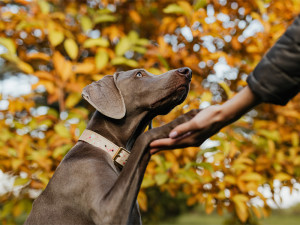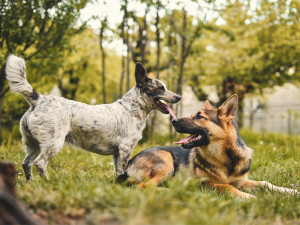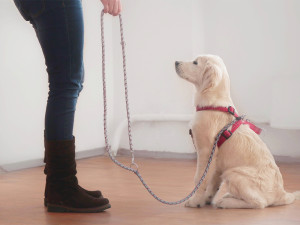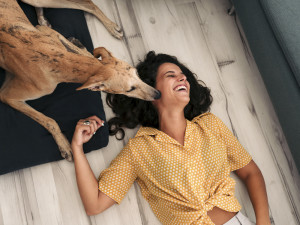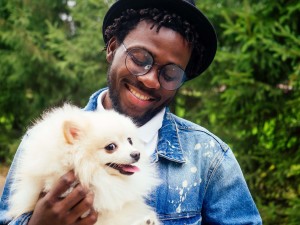What’s the Point?
Studies explain dogs’ ability to follow gestures.
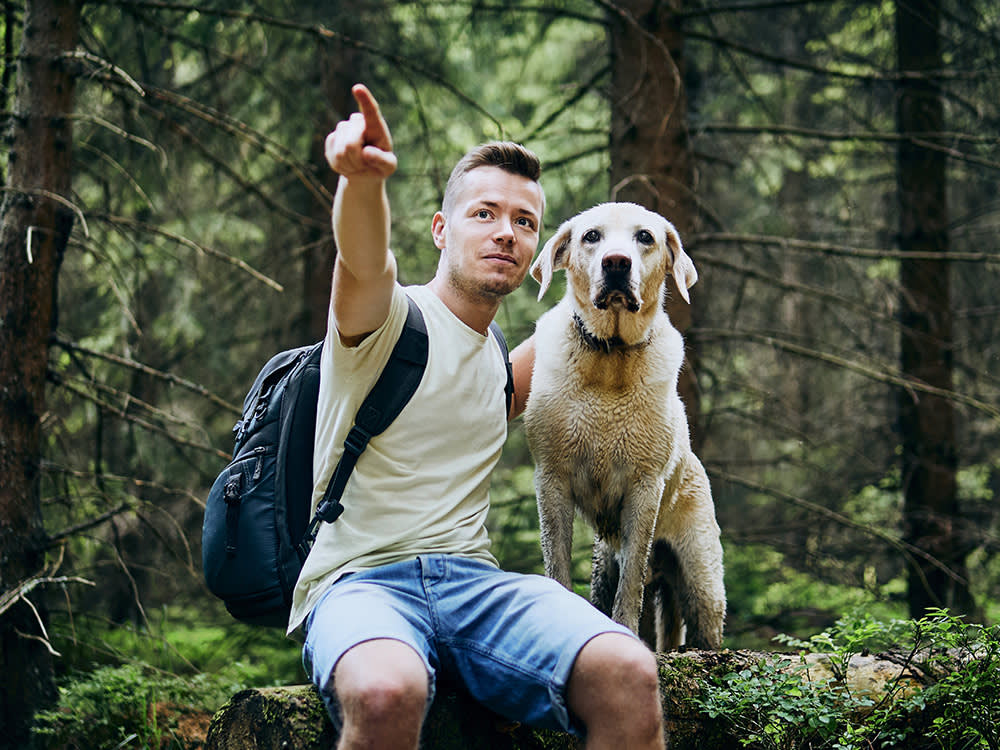
Share Article
If you’ve spent any time with dogs, you aren’t surprised when a dog stops to check out the ground. It also shouldn’t surprise you that a dog might go where you point. Pointing is about social communication, and it often feels like dogs are right there with us, sometimes even more than members of our own species.
In the last 20 years, dogs’ attention to our communicative gestures — particularly this thing we do with our arm and finger — has attracted enormous attention from researchers around the globe. In fact, the pointing gesture is so fundamental that seemingly no article on the canine mind is complete without a sentence such as “dogs read our gestures, like pointing, more flexibly than any other animal” (New York Times), or — more boldly in Time — “While chimps and even wolves lack an innate ability to understand what pointing means, dogs come by the knowledge naturally.”
These statements tend to produce any number of reactions in pet parents, from “Obviously,” sometimes accompanied with a side of, “Why do they bother to do this research anyway?” to the flip side: “My dog doesn’t do that … what are they talking about?” Or even the more nihilistic view: “Sure they do, but who cares?”
Here’s why we care: this one little gesture, in all its complexity, could be a core feature of the intimate bond we share with dogs. Find out why dogs understand pointing and the research to back it up.

What is pointing all about?
Researchers have tried to uncover why and how dogs pick up on our cues. Initially, key questions focused on whether their ability to follow the pointing gesture arose from our long-standing co-evolutionary history or, alternatively, if they learned the behavior over the course of their individual lives.
Pointing is something we humans do as part of our social communication, and it is useful only because we all agree on how it should be interpreted. Imagine if your point were perceived as, “Hey! Check out my fingertip. No dirt under my nail. Wonderful, huh?” Not exactly useful for communication. Fortunately, we understand that pointing creates a shared experience beyond our fingertips; pointing draws someone’s attention past our outstretched index finger to something out there in the world.
This cooperative gesture serves us well. Yelling, “Look out!” is only somewhat informative, but yelling, “Look out!” and pointing can help a fellow human locate and respond to a Frisbee sailing in at head level or Godzilla rampaging down Fifth Avenue. Communication achieved.
Despite our mothers’ reminders that pointing is rude, it has a function: it reflects our ability to hold shared attention with others, which could also indicate that someone else is aware of the same thing that we are. Pretty meta. Joint attention can thus be associated with an ability to infer others’ mental states, which is considered an important social capability in humans.
At about six months, children start following the gaze and gestures of others. We start pointing around our first birthday and become increasingly point-savvy as we age. When toddlers see something of interest and point at it, they become excited when we also look. They will also point when seeking something or to provide information (I want that. You dropped something). Regardless of how it’s used or understood at any given age or moment, pointing intrinsically aids our communication with one another.
Do dogs get the point?
It shouldn’t come as a surprise that much of the academic interest in the canine mind that blossomed in the late 1990s was actually largely about us, investigating to what extent dogs responded to our communicative gestures — notably, our pointing. In research labs around the world, it has been a pointing party ever since.
Watch any program covering research into the canine mind and you’re bound to hear mention of studies involving a dog, two cups and a pointing human. The experiment, commonly referred to as the object-choice task, follows some variation of this procedure: a dog first learns he can get a treat for approaching either of two identical cups. He then watches as a person points to one of the cups. Will the dog follow the point to the cup?
Human children are quite good at this task, and numerous studies confirm that dogs are, too. From an early age, dogs are highly responsive to this gesture. Dogs do well when a person points with a foot, or bows or nods. They’ll also respond to what’s commonly referred to as a “momentary” point, in which the person points and then lowers their arm before the dog makes a choice. They will follow the point even when a person stands by one cup and points at the other. Although we all know smell is a major player in the canine world, it doesn’t appear to factor greatly into dog performance; when food is hidden under one cup and nobody points, they don’t do so well. Some researchers describe their performance as “remarkable” and “outstandingly flexible.”
Not all species catch our communicative drift.
A bee that flies into your car will never be aided by your outstretched arm pointing toward the open window. Given dogs’ long history with us, researchers wondered whether canine sensitivity arose through the domestication process — in which case, wolves, their closest relative, might be less adept in this task — or, on the other hand, whether it’s a product of learning and dogs’ individual life experiences. Or maybe the reality is not so black-and-white. What underlies their highly flexible ability?
Wolves do not follow our gestures as flexibly as dogs. Nor do chimpanzees, our closest relatives. This isn’t to say that wolves (or chimpanzees) can’t or don’t do it. Extensively socialized wolves and enculturated chimps — those highly familiarized with human behavior — can follow our points, but dogs generally respond more readily and easily, and wolves need more exposure to perform similarly. In 2002, Brian Hare of the Duke Canine Cognition Center pulled together then-current research on dogs, wolves and chimpanzees and, in an article in Science, concluded, “Dogs’ social-communicative skills with humans were acquired during the process of domestication.”
Science behind dog’s ability to understand pointing.
Breed Matters
More immediate genetic influences, like artificial selection, could also influence dogs’ skills. Márta Gácsi and colleagues at the Family Dog Project in Budapest found that while all dogs tested followed the point better than chance would predict, dogs bred for cooperative work (like gun dogs) performed better than those bred for independent work (like guard dogs). All the dogs in the study were living as pets and none had received special training, implying that genetics plays a role at some level in enhancing dogs’ ability to follow our gestures.
Life Experience
At the same time, individual life experiences could also contribute to a dog’s responsiveness. For example, the reactions of shelter dogs to our pointing gestures vary widely, and a small group of intensively socialized lab-raised dogs did not fare well in the task.
Lucia Lazarowski of the Comparative Cognition Laboratory at Auburn University, one of the investigators in the lab-raised dog study, saw their challenges first-hand. But when she later adopted Captain, a study participant, and informally examined his responsiveness to pointing, she found he performed much better in her home: “He actually looked in the direction I pointed and sniffed in the area I was pointing to. During the test, however, he was one of the more non-responsive dogs. Now, we like to play a game where I toss small treats around the room for him to hunt, and if he can’t find them, sometimes I’ll point to them, so he probably has picked it up from that.” Captain’s transition to canine point-follower highlights that learning and life experiences can factor into the skill.
Who’s Pointing
The person behind the point can also affect dog performance. Amy Cook, CDBC, CPDT-KA, conducted a study on the topic at the University of California, Berkeley; reporting in Animal Cognition, Cook noted that when pet parents and strangers were pitted against one another (in what I hope was described as a “point-off”), dogs tended to follow their people, even when they received no reward (i.e., the point did not lead to the dog getting food). As Cook explains, “Dogs make decisions by attending preferentially to social signals from humans with whom they have become more familiar.” Many of us think it’s all about us, and our dogs might agree.
If dogs respond to the pointing gesture based on whose finger is doing the work, then again, it looks like life experiences could be controlling the switches. But not so fast: Cook suggests that this unique spin on the issue — dogs being more attentive to a familiar person — could have been shaped by evolutionary pressures to bond with a caretaker. Attachment relationships between dogs and their humans are well documented and, as Cook says, going with your person could be “a successful strategy in the long term.”
Quick Learners
Isn’t it nice when everyone can be right? Dog responsiveness to our communicative gestures could be a product of their evolutionary history plus their ability to learn rapidly once in a human environment. In a 2009 article in Behavioural Processes, Pamela Reid, CAAB and vice president of the ASPCA’s Anti-Cruelty Behavior Team, reflects on what’s behind canine responsiveness to our social cues: “Dogs are too skilled for it to be pure trial-and-error learning. Yet it is improbable that a versatile behavior like this would be largely innate.”
She suggests that what we see in dogs is an adaptive specialization of learning. “In essence, they come with a built-in head start to learn the significance of people’s gestures, in much the same way that white-crowned sparrows acquire their species-typical song and ducklings imprint on their own kind.” This fits in well with what is understood as instinctual or innate behaviors. As Jack Hailman explained in his influential piece in Scientific American in 1969, “How an Instinct Is Learned,” species-specific behaviors require some amount of experience and development.
When Patricia McConnell, CAAB, mulled over the pointing research on her blog, “The Other End of the Leash,” she agreed that dogs could be “predisposed to learn to follow a pointing gesture.” McConnell also highlights something you might have seen yourself: present a very young puppy with an outstretched finger and that puppy is going to approach your fingertip, not follow it to a distant location. McConnell’s point is that point-following in puppies is not automatic, although they learn it very easily.
To this, Reid adds, “Just because a skill appears early in development does not preclude learning. It does, however, demand that puppies be highly attentive to the actions of humans, a tendency that has been confirmed in studies of dog-human attachment.”
Do dogs understand what pointing means?
What do dogs think of all this? What does it mean to be a dog who “understands” our pointing gesture? A 2013 article by Ádám Miklósi and József Topál of the Family Dog Project in Trends in Cognitive Sciences concludes by highlighting that “dog social competence [appears] sometimes ‘infant-like’ or ‘human-like,’ but, importantly, the underlying mental mechanisms may turn out to be quite different.”
It’s hard enough for us to figure out if, for example, our boss is merely suggesting that we do something or telling us to do it. The same is true for dogs and the pointing gesture. Do dogs see pointing as an imperative — “You. Go there.” — or as simply providing information or a helpful suggestion — “I recommend that you go there.” — a subtle yet meaningful difference. A 2011 article published in Applied Animal Behaviour Science by Helene Pettersson and colleagues found that, like children, dogs are more likely to follow a point when it is accompanied by a cooperative tone of voice as opposed to a prohibitive tone. At the same time, dogs sometimes follow the point to an empty container, leading some to wonder whether, under certain circumstances, dogs might perceive the gesture as a command.
Like humans, dogs seem to distinguish when communication is — or is not — intended for them, although they could be relying on a more limited set of cues. Numerous studies find that initiating eye contact and using high-pitched vocalizations help dogs understand that the communication is for them. The setting is also important. In a 2011 study reported in PLoS ONE, Linda Scheider and colleagues found that if a person points to a location where a dog has never experienced reinforcement, the dog is not as likely to follow as he would be if he had previously received reinforcement there (making me wonder whether the ring-bearer dog would spontaneously follow the point to the altar).
At some level, every pointing gesture suffers from a fundamental ambiguity: we might be pointing to a particular object, or we might be pointing to a specific space that happens to be inhabited by a particular object. Usually, we can figure it out without too much cognitive difficulty. Even nine-month-old infants understand when pointing refers to an object as opposed to the place where the object is located.
How about dogs? In a study recently published in the Journal of Comparative Psychology by Tibor Tauzin and colleagues, an experimenter pointed at one of two different toys on either side of him. Before the dog could approach, the experimenter switched the location of the objects in full view of the dog. The researchers wondered whether the dog would approach the object that had initially been pointed at, but that was now in a new location, or to the original location of the point. The result? Dogs did not follow the object to its new location. Instead, they approached the old location, which seems to imply that, for the dog, pointing could be more about the location than the pointed-at object.
For those of us who live or work with dogs, much of the value of pointing studies lies in what we do with the results. Despite being unflashy, the pointing gesture is actually rich in dimensions and angles that we can explore with our dogs. As Reid recommends, “Take note of your body gestures. Does your dog attend to your gestures in all cases, or only in certain contexts? Dogs are often way more sensitive than we can grasp. They’re not trying to fool you or trick you, get one over on you, or cheat the system. Attending to our gestures is just what dogs do. It’s who they are.”
References
Cook, A., et al. 2014. My owner right or wrong: the effect of familiarity on the domestic dog’s behavior in a food-choice taskopens in new tab. Animal Cognition 17: 461–470.
Franco, F., and G. Butterworth. 1996. Pointing and social awareness: declaring and requesting in the second yearopens in new tab. Journal of Child Language 12(2): 307–336.
Gácsi, M., et al. 2009. Effect of selection for cooperation and attention in dogsopens in new tab. Behavioral and Brain Functions 5:31.
Hailman, J.P. 1969. How an Instinct Is Learnedopens in new tab. Scientific American 221(6): 98–106.
Hare, B., et al. 2002. The domestication of social cognition in dogsopens in new tab. Science 298(5598): 1634–1636.
Hochman, D. 2014. You’ll Go Far, My Petopens in new tab. New York Times, April 11.
Kaminski, J., et al. 2011. How dogs know when communication is intended for themopens in new tab. Developmental Science 15: 222–232.
— — — and J. Nitzschner. 2013. Do dogs get the point? A review of dog-human communication abilityopens in new tab. Learning and Motivation 44(4): 294–302.
Lazarowski, L., and D.C. Dorman. 2015. A comparison of pet and purpose-bred research dog (Canis familiaris) performance on human-guided object-choice tasks.opens in new tab[1] Behavioural Processes 110: 60–67.
Miklósi, A., and J. Topál. 2013. What does it take to become ‘best friends’? Evolutionary changes in canine social competenceopens in new tab. Trends in Cognitive Sciences 17(6): 287–294.
Pettersson, H., et al. 2011. Understanding of human communicative motives in domestic dogsopens in new tab. Applied Animal Behaviour Science 133(3-4): 235–245.
Reid, P. 2009. Adapting to the human world: Dog’s responsiveness to our social cuesopens in new tab. Behavioural Processes 80(3): 325–333.
Scaife, M., and J.S. Bruner. 1975. The capacity for joint visual attention in the infantopens in new tab. Nature 253: 265–266.
Scheider, L., et al. 2011. Domestic dogs use contextual information and tone of voice when following a human pointing gestureopens in new tab. PLoS ONE 6(7): e21676.
— — — , et al. 2013. Do domestic dogs interpret pointing as a command?opens in new tab Animal Cognition 16: 361–372.
Tauzin, T., et al. 2015. What or where? The meaning of referential human pointing for dogs (Canis familiaris)opens in new tab. Journal of Comparative Psychology 129(4): 334–348.
Udell, M., et al. 2008. Wolves outperform dogs in following human social cuesopens in new tab. Animal Behaviour 76: 1767–1773.
Zimmer, C. 2009. The Secrets Inside Your Dog’s Mindopens in new tab. Time, September 21.

Julie Hecht, MSc
Julie Hecht, MSc, is a Ph.D candidate studying animal behavior at the Graduate Center, CUNY, and author of the Dog Spies blog at Scientific American. Her academic publications are featured in Applied Animal Behaviour Science and Animal Behavior for Shelter Veterinarians and Staff. She would really like to meet your dog and thinks that her cat, Josh, excels at being himself. And she loves him for it.
Related articles
![profile portrait of grumpy a ginger dog, inside on a golden retro velvet armchair]()
Your Grumpy Dog Is Very Smart—Science Says So
This study found that cranky pups are actually very fast social learners.
![a dog held on a leash sits calmly]()
Dogs Who Are Easy to Train: Top 10 Easiest Dogs to Train
Spoiler: It’s not about the breed. But these pups are pretty brainy.
![A woman lying on the floor laughing with her dog.]()
How to Describe Your Dog—Besides “Smart”
According to animal behaviorist Karen London, using a more specific terms like “biddable” or “bombproof” can help you better understand your dog.
![Man hugging his fluffy white dog happily]()
Chemistry Between People and Dogs Is Real (It’s Science)
How the “love hormone” oxytocin connects us with our pups.


